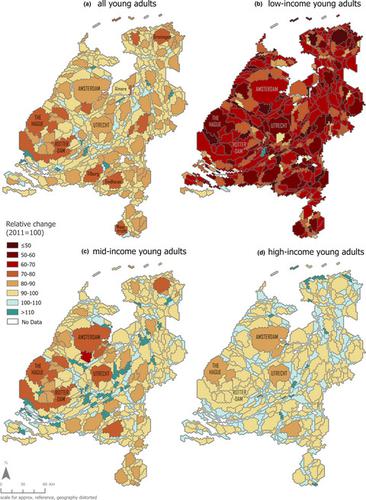当前位置:
X-MOL 学术
›
Trans. Instit. Br. Geogr.
›
论文详情
Our official English website, www.x-mol.net, welcomes your
feedback! (Note: you will need to create a separate account there.)
The unequal geography of declining young adult homeownership: Divides across age, class, and space
Transactions of the Institute of British Geographers ( IF 3.3 ) Pub Date : 2021-05-11 , DOI: 10.1111/tran.12466 Cody Hochstenbach 1 , Rowan Arundel 1
Transactions of the Institute of British Geographers ( IF 3.3 ) Pub Date : 2021-05-11 , DOI: 10.1111/tran.12466 Cody Hochstenbach 1 , Rowan Arundel 1
Affiliation

|
Across countries, the position of young adults on the housing market has worsened over the past decade. Young adults’ decreasing access to homeownership has garnered particular attention. Most studies analysing young adults’ housing market entry focus on micro-level determinants or national-level patterns and trends. This paper adds an important perspective by focusing on spatial variations within a single country, unravelling pronounced inter-municipal differences in homeownership across age and class. Our case is the Netherlands, where we use full-population register data for the 2011–2018 period to analyse spatial patterns and trends using a range of quantitative spatial methods. Our findings highlight a notable decrease in owner-occupancy among young adults in the Netherlands over the period. Such overall declines, however, belie clear class divisions, with decreases particularly concentrated among low-income young adults. Untangling spatial dynamics reveals both important geographic commonalities and clear divergences. Declining young homeownership was found across 87% of municipalities, suggesting a common experience. Analyses also reveal stark spatial disparities, with the strongest decreases in the most urbanised regions, particularly large cities. Spatially divergent patterns of housing market exclusion are furthermore highly classed: widespread among young adults with a low income, while more spatially concentrated among those with a high income. Finally, using advanced spatial regression modelling, we explore municipal characteristics, revealing how local housing and population factors may explain pronounced differences in changing young adult homeownership entry. The analyses particularly emphasise links between housing unaffordability and competition as determinants of worsening homeownership opportunities for young adults.
中文翻译:

年轻成人房屋所有权下降的不平等地理:按年龄、阶级和空间划分
在过去十年中,各国年轻人在房地产市场上的地位不断恶化。年轻人获得房屋所有权的机会越来越少,这引起了特别的关注。大多数分析年轻人进入住房市场的研究都集中在微观层面的决定因素或国家层面的模式和趋势上。本文通过关注单个国家/地区的空间变化,增加了一个重要的视角,揭示了不同年龄和阶层的住房所有权的显着城市间差异。我们的案例是荷兰,我们使用 2011-2018 年期间的全人口登记数据,使用一系列定量空间方法分析空间模式和趋势。我们的研究结果强调了在此期间荷兰年轻人的自住率显着下降。然而,这样的总体下降,掩盖了明显的阶级划分,减少尤其集中在低收入的年轻人中。解开空间动态揭示了重要的地理共性和明显的分歧。在 87% 的城市中发现年轻的房屋所有权下降,这表明存在共同的经历。分析还揭示了明显的空间差异,在城市化程度最高的地区,尤其是大城市,下降幅度最大。此外,住房市场排斥的空间差异模式被高度分类:普遍存在于低收入的年轻人中,而空间上更多地集中在高收入人群中。最后,使用先进的空间回归模型,我们探索城市特征,揭示当地住房和人口因素如何解释改变年轻成人住房所有权的显着差异。这些分析特别强调了住房负担能力和竞争之间的联系,这是年轻人拥有住房机会恶化的决定因素。
更新日期:2021-05-11
中文翻译:

年轻成人房屋所有权下降的不平等地理:按年龄、阶级和空间划分
在过去十年中,各国年轻人在房地产市场上的地位不断恶化。年轻人获得房屋所有权的机会越来越少,这引起了特别的关注。大多数分析年轻人进入住房市场的研究都集中在微观层面的决定因素或国家层面的模式和趋势上。本文通过关注单个国家/地区的空间变化,增加了一个重要的视角,揭示了不同年龄和阶层的住房所有权的显着城市间差异。我们的案例是荷兰,我们使用 2011-2018 年期间的全人口登记数据,使用一系列定量空间方法分析空间模式和趋势。我们的研究结果强调了在此期间荷兰年轻人的自住率显着下降。然而,这样的总体下降,掩盖了明显的阶级划分,减少尤其集中在低收入的年轻人中。解开空间动态揭示了重要的地理共性和明显的分歧。在 87% 的城市中发现年轻的房屋所有权下降,这表明存在共同的经历。分析还揭示了明显的空间差异,在城市化程度最高的地区,尤其是大城市,下降幅度最大。此外,住房市场排斥的空间差异模式被高度分类:普遍存在于低收入的年轻人中,而空间上更多地集中在高收入人群中。最后,使用先进的空间回归模型,我们探索城市特征,揭示当地住房和人口因素如何解释改变年轻成人住房所有权的显着差异。这些分析特别强调了住房负担能力和竞争之间的联系,这是年轻人拥有住房机会恶化的决定因素。











































 京公网安备 11010802027423号
京公网安备 11010802027423号